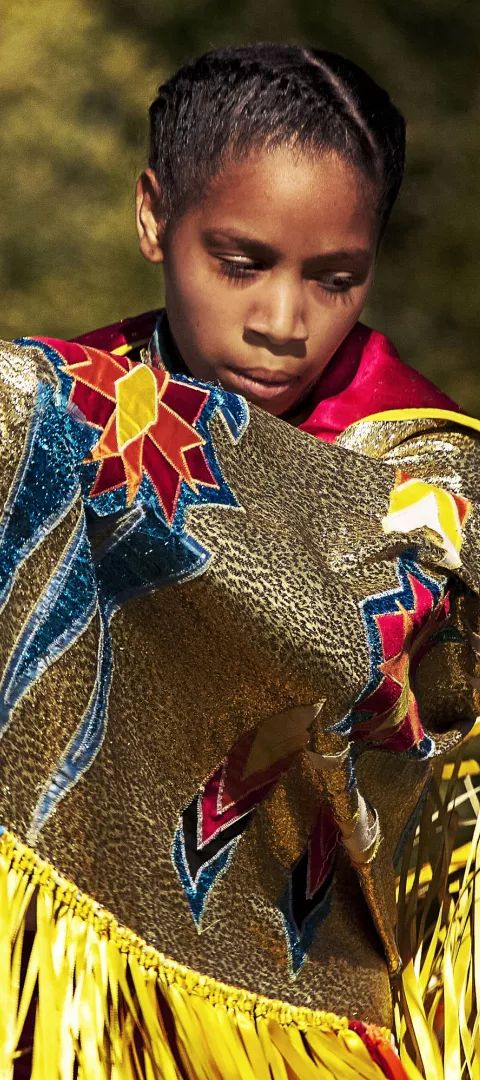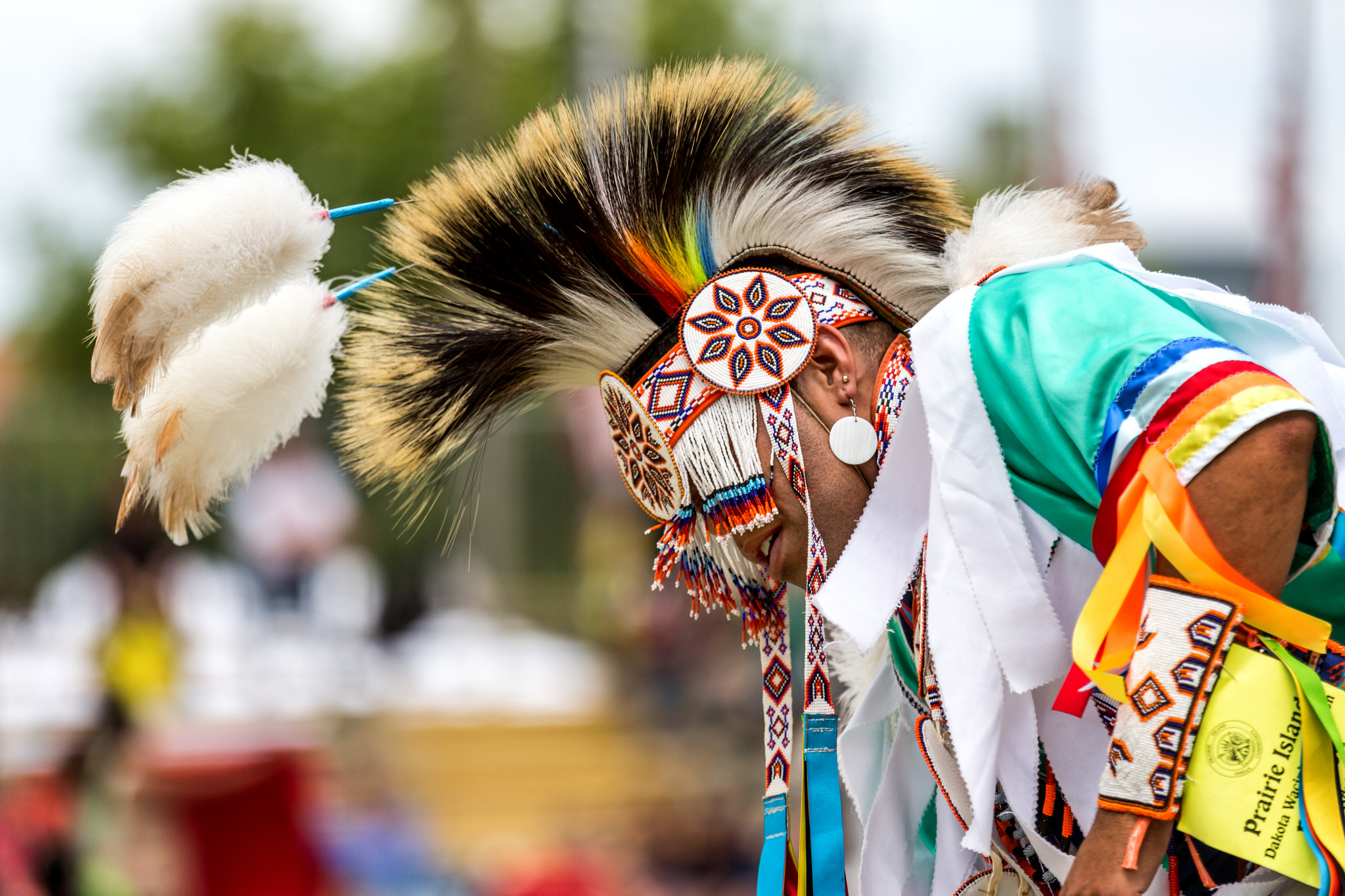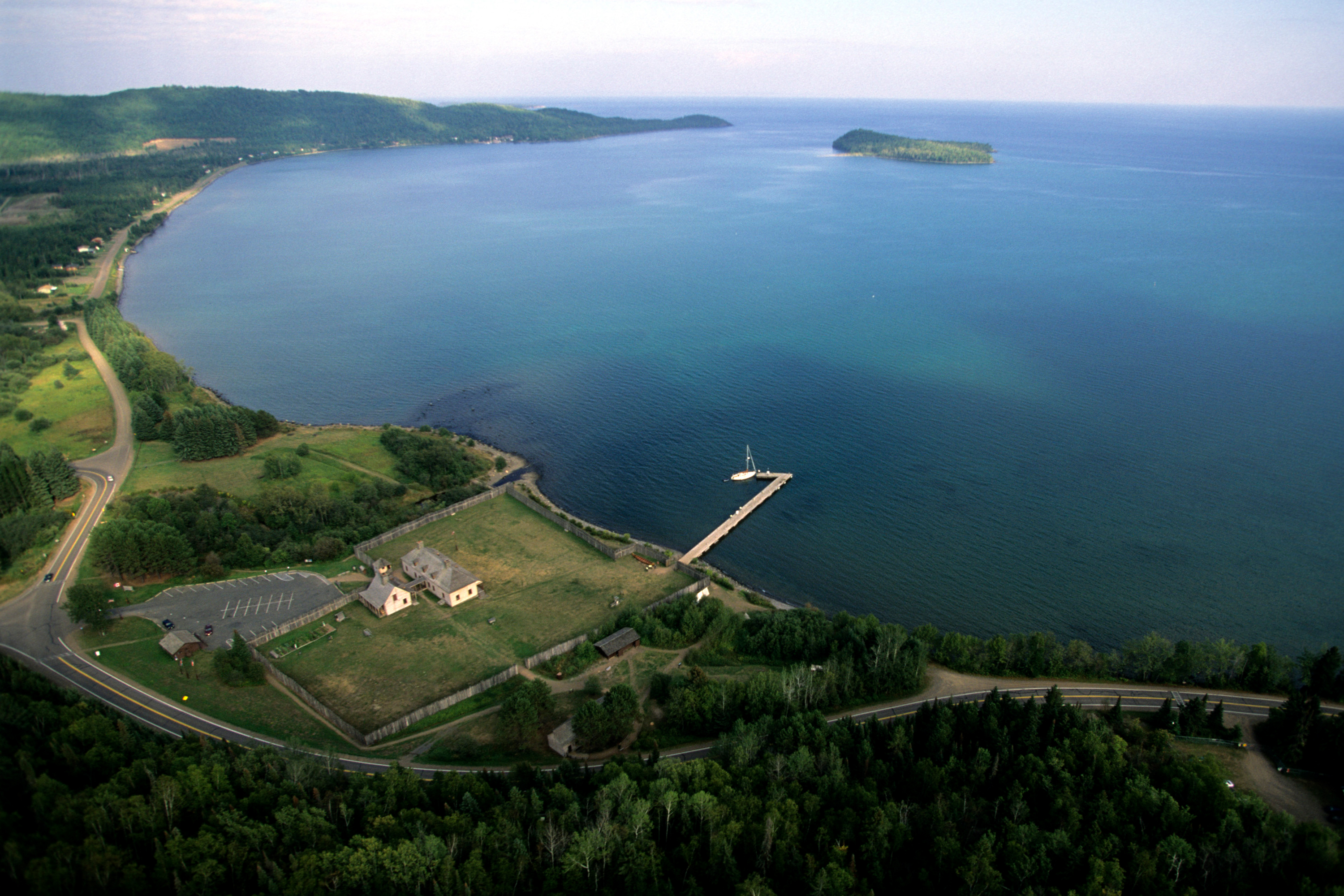
Museums & Historic Sites Share Native American Cultures
Museums & Historic Sites Share Native American Cultures
By Lisa Meyers McClintick
Ojibwe and Dakota culture figure strongly in Minnesota’s past and its present. Here are some of the best places to admire tribal artistry, learn about the histories and appreciate the cultures through storytelling and music, along with a little background on language and local tribes.

A dancer at the Prairie Island Indian Community Wacipi near Red Wing / Credit: Lorie Shaull
THE MEANING OF MINNESOTA
The name Minnesota comes from the Dakota words mnisota, meaning "sky-tinted waters" or "sky-blue waters." There are numerous Indian origin place names throughout the state, many beginning with mni or minne, meaning water. For example, Minneapolis is a hybrid of "minne" and "polis," the Greek word for city, which together form "city of water" or "City of Lakes."
Dakota and Ojibwe languages, family, political structure and spirituality arose from and were shaped by the landscape. In Minnesota, there are seven Ojibwe reservations and four Dakota communities.
A reservation or community is a portion of land reserved by a Tribe/Tribal government and is held in trust for them by the federal government. This land that was NOT given to Native Americans by the federal government. It is land that was retained by Native American Tribes after ceding large portions of the original homelands to the United States through treaties (the supreme law of the land in federal terminology).

Native American quilts for sale at the Mille Lacs Indian Museum and Trading Post / Mille Lacs Area Tourism
MILLE LACS INDIAN MUSEUM & TRADING POST
An Ojibwe woman weaving an intricate basket from sweet grass grabs the attention of older visitors, but kids feel tugged forward into the Mille Lacs Indian Museum by the spiritual drumming, distinctive singing and colorful dancers. Visitors can toggle between videos that show women’s vibrant shawl dances and upbeat jingle dress dances and men’s kinetic dances that draw inspiration from animals and birds.
This lakeshore museum tells the story of the Mille Lacs Band of Ojibwe arriving in northern Minnesota. A room with dioramas shows how they follow a rhythm of four seasons by harvesting maple syrup, fishing, gathering berries, harvesting and drying wild rice, trapping and hunting. Besides seeing the indoor demonstrations and partaking in classes on weaving, beading and traditional cooking, visitors should also look for seasonal programs on maple syruping, ricing, traditional dances and building canoes or tipis.
The museum, along with its trading post and extensive book store, can be especially busy in mid-August during the annual powwow. The event, which takes place at the powwow grounds on the Lake Mille Lacs shore two miles north of the museum, has been a tradition since the 1950s.

Bois Forte Heritage Center and Cultural Museum
BOIS FORTE HERITAGE MUSEUM
Tucked behind the Fortune Bay Resort and Casino near Tower, this gem of a museum tells how the Bois Forte Ojibwe were told to wander west until they reached where the "food grows upon the water", shallow-shored lakes rich with wild rice.
The exhibits include a sobering section on the Bois Forte Indian boarding school history, an area that pays tribute to the tribe’s many veterans, and a replica of an early birchbark-covered dwelling.

A couple hikers at Pipestone National Monument / Paul Vincent
PIPESTONE NATIONAL MONUMENT
Minnesota's recorded history begins at Jeffers Petroglyphs Historic Site in the southwest corner of the state where for thousands of years Native Americans have traced life stories in rock carvings. Near Jeffers Petroglyphs is the "Crossroads of the Indian World," at The Great Pipestone Quarries, now the Pipestone National Monument.
The Pipestone quarries of Minnesota have been a sacred site for Native Americans for more than 1,000 years. Many nations came to these quarries as the pipestone was a very precious trade item and had significant spiritual meaning for Tribal National throughout the Americas. As a result, the Pipestone region became the major crossroads for trade.

Pipestone National Monument / Paul Vincent
Today, pipestone articles are sold by the Pipestone Indian Shrine Association, which runs the gift shop at the Monument, and The Keepers of the Sacred Tradition of Pipemakers at a gift shop and gallery in the town of Pipestone. Both shops are owned and operated by Native Americans.
Tucked among the rolling prairie landscape, reddish pink pipestone (or catlinite) can still be found and hand-quarried following traditions of more than 2,000 years. Soft enough to skillfully carve into animal shapes and other art and spiritual objects, the prized pipestone became one of their most cherished and sacred possessions.
Carvers may still be seen carefully sculpting and sanding the rock at the Pipestone National Monument visitor center, which includes exhibits on pipestone history and the efforts to protect this sacred site. A scenic walking trail includes a look at prairie, small quarries and the beautiful Winnewissa Falls.

An aerial view of Grand Portage National Monument
GRAND PORTAGE NATIONAL MONUMENT
The Grand Portage National Monument along Lake Superior focuses on the North West Fur Company during the early 1800s North American fur trade. The large complex of buildings celebrate the fur trade and Ojibwe way of life. The portage trail has been designated a Minnesota State Historic Site.
As early as 2,000 years ago, Native Americans used Gichi-onigaming, or "the great carrying place," to travel from summer homes on Lake Superior to winter hunting grounds in the interior of Minnesota and Ontario. The Grand Portage trail is an 8.5-mile (13.7 km) portage around the High Falls on the Pigeon River which forms the border between Minnesota and Ontario, Canada. Voyageurs from the interior of Canada would carry their furs by canoe down river to Grand Portage.

The Grand Portage Annual Powwow and Rendezvous / Credit: Stephan Hoglund
The visitor center uses technology such as projecting digital images into a tipi and participatory virtual trading that captures how families would survive the winter. Costumed interpreters at the historic fort explain life in the fur era, which was always liveliest during the annual North West Company Rendezvous. Re-enactors continue this event the second full weekend in August in conjunction with the Rendezvous Days Powwow, sponsored by the Grand Portage Reservation.
Nearby, petroglyphs can be found in the Boundary Waters Canoe Area Wilderness of northern Minnesota. Within the Boundary Waters are hundreds of these petroglyphs and pictographs on rock ledges and cliffs. The area is part of the homeland of the Ojibwe/Anishinabe who traveled the waterways in birch bark canoes.

Upper Sioux Agency State Park, Granite Falls
MINNESOTA RIVER VALLEY
The 1851 Traverse des Sioux Treaty and the Treaty of Mendota ceded close to 24 million acres of the Dakota territory to European settlement. Restricted to reservation lands but guaranteed payments that never arrived to those for which they were intended, the Dakota were starving a decade later when Civil War gripped America and the payments still were not delivered as promised. Frustrations exploded into the violent and short but deadly, U.S. Dakota War in 1862, and the resulting execution of 38 Dakota men. Two additional men were executed days after the largest mass execution in U.S. history.
The Treaty Site History Center near St. Peter illustrates this historical turning point. Other parts of the story are told at sites all along the Minnesota River Valley. Other notable stops include the Lower Sioux Agency historic site near Morton, New Ulm’s Brown County Historical Society, Fort Ridgely State Park near Fairfax, and Historic Fort Snelling in the Twin Cities.

A dancer at the Prairie Island Indian Community Wacipi near Red Wing / Credit: Lorie Shaull
POWWOWS
Powwows have long been held to celebrate a successful hunt and to thank the spirits for a bountiful harvest. Powwows also spiritually prepared a warrior for an impending battle or celebrated many life events. Today, the powwow tradition has become a multi-tribal social event most often open to the public. Native American arts and crafts, as well as food are often for sale.

Mystic Lake Casino Hotel
CASINOS
Tribal Governments sharing geography with Minnesota were the first in the nation to negotiate and sign gaming compacts with a state government. Gaming revenues have helped Minnesota tribes fill the gaps left by chronically inadequate federal funding for health care, housing, education, human services and infrastructure needs. The casinos are central to Minnesota tourism and essential to Native American community revenue.


